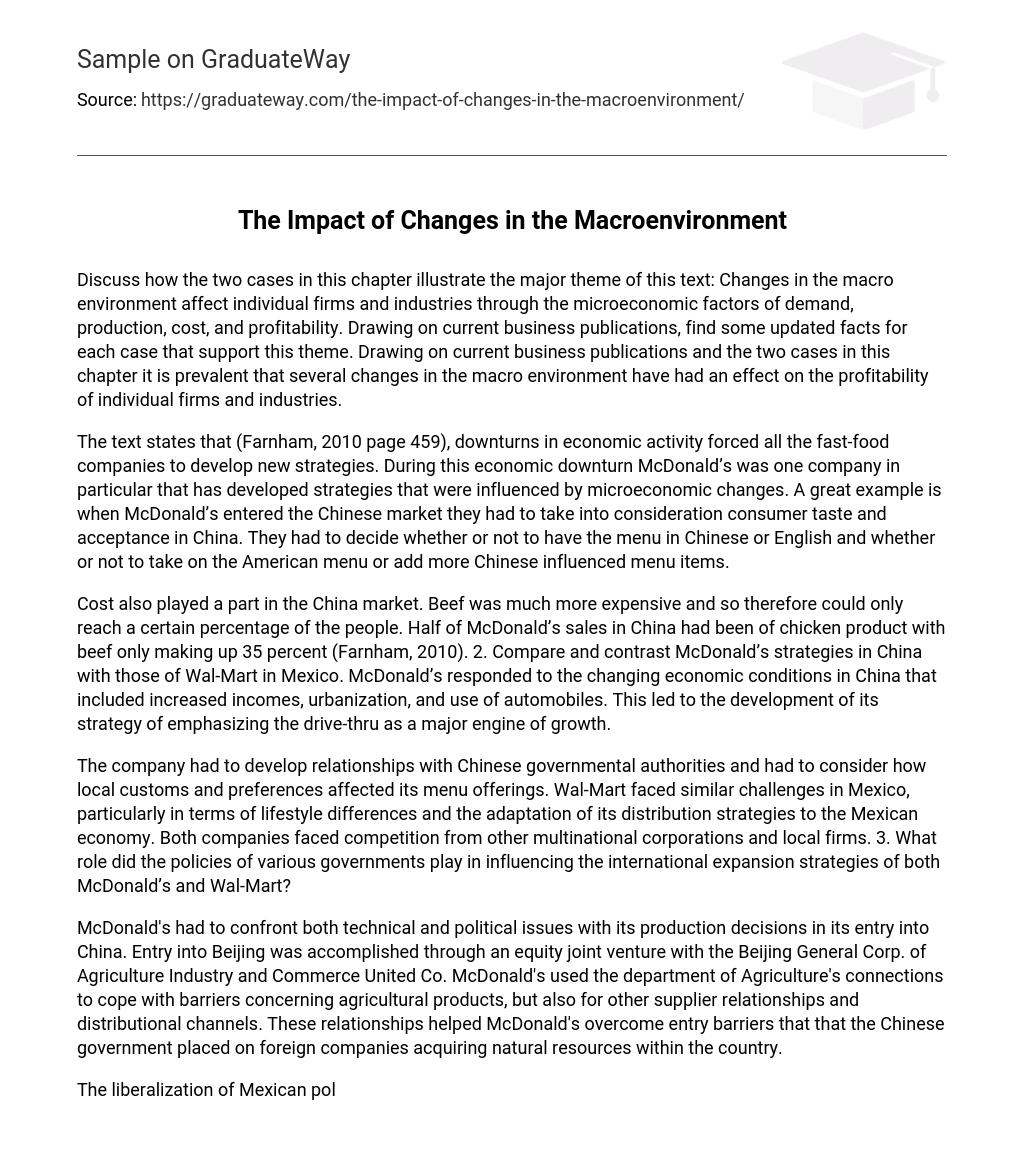The major theme of this text is how changes in the macro environment impact individual firms and industries through microeconomic factors such as demand, production, cost, and profitability. By examining current business publications and the two cases in this chapter, it is evident that various changes in the macro environment have influenced the profitability of individual firms and industries.
According to Farnham (2010 page 459), the downturns in economic activity compelled fast-food companies to devise new strategies. McDonald’s, in particular, was influenced by microeconomic changes and implemented strategies during this economic downturn. When McDonald’s expanded into the Chinese market, they had to consider consumer taste and acceptance in China. They had to make decisions regarding the language of the menu (Chinese or English) and whether to incorporate more Chinese-influenced menu items alongside their American menu options.
The cost of beef, being higher in China, limited its accessibility to a certain portion of the population. In fact, chicken products constituted half of McDonald’s sales in China, whereas beef contributed only 35 percent (Farnham, 2010). On the other hand, McDonald’s in China adapted to the changing economic landscape by addressing factors like rising incomes, urbanization, and increased use of automobiles. As a result, the drive-thru became a key growth driver for the company.
Comparatively, Wal-Mart in Mexico had distinct strategies which can be juxtaposed with those of McDonald’s in China.
Both McDonald’s and Wal-Mart encountered challenges in their international expansion strategies. McDonald’s had to develop relationships with Chinese governmental authorities and consider local customs and preferences that affected its menu offerings. Similarly, Wal-Mart faced similar challenges in Mexico, including adapting its distribution strategies to fit the Mexican economy and addressing lifestyle differences. Both companies also faced competition from both multinational corporations and local firms. The policies of various governments played a significant role in influencing the international expansion strategies of McDonald’s and Wal-Mart.
McDonald’s faced both technical and political challenges when it entered the Chinese market. To establish its presence in Beijing, the company formed an equity joint venture with the Beijing General Corp. of Agriculture Industry and Commerce United Co. McDonald’s leveraged the department of Agriculture’s connections not only to address barriers related to agricultural products but also to navigate supplier relationships and distribution channels. These partnerships enabled McDonald’s to overcome entry restrictions imposed by the Chinese government on foreign companies seeking access to natural resources in the country.
The Mexican government underwent decentralization and the economy became more liberalized, leading to consumption patterns similar to developed countries. The influence of U.S. business cycles on Mexico’s output fluctuations has grown due to increased trade between the two countries. In preparation for the North American Free Trade Agreement, Carrefour, Ahold, and Wal-Mart joined forces with Mexican companies through joint ventures and strategic alliances.
Many American companies with knowledge about the NAFTA negotiations started seeking partnerships with Mexican companies (Farnham, 2010). Additionally, McDonald’s has concentrated on altering taste preferences by creating healthier options in their menus. They have introduced Happy Meals and playgrounds in stores to attract children. Out of factors other than price, these initiatives seem to have the greatest impact on the demand for McDonald’s products. Furthermore, the company possesses significant control over these variables.
The company has hired mystery shoppers to assess service, cleanliness, and food quality in order to enhance the quality of its service. McDonald’s has implemented diverse menus and restaurant designs in different countries globally. Furthermore, the business publications highlight a case study where changes in the macro environment significantly impact a firm’s competitive strategy. In contrast, another case study emphasizes the importance of micro factors. FirstGroup plc. (First), the largest surface transportation company in the UK, will be examined in this instance.
First is a significant company for the UK’s economy, generating over 5 billion pounds in revenues annually and employing more than 135,000 people. Recently, political influences and governmental policy changes have become a major macroeconomic factor for First. These changes have necessitated significant adjustments to the company’s policies and future business plans. In 1997, the UK committed to the Kyoto protocol, aimed at reducing CO2 emissions among participating nations. As First’s main sources of revenue are rail and bus systems, these sectors rank as the fourth and third highest contributors to CO2 emissions in the UK, respectively.
The UK acknowledges the need to collaborate with businesses responsible for a significant portion of emissions in order to achieve its emission goals. In addition to the Kyoto protocol, there has been a societal shift towards greater awareness of the detrimental impact of engine emissions. This shift has also affected First’s strategy. Although rail and bus systems do emit CO2, their emissions are considerably lower compared to automobiles and air travel.
First implemented several changes in response to governmental and societal changes, aiming to become more environmentally friendly. Their measures include:
- Improving the efficiency of their vehicles
- Purchasing new vehicles with greater fuel efficiency
- Increasing the use of bio-fuels
- Implementing operational improvements through driver training and new technology for monitoring driver performance
In addition to these changes, First also adopted a ‘Climate Change Strategy’ that guides their decision-making process. This strategy also includes efforts to improve public perception of public transportation.
First has achieved success in their endeavors. Rail usage witnessed an 8% increase from 2006 to 2007, while bus utilization grew by 4%. Despite being beyond First’s influence, the signing of the Kyoto protocol by the British government had a significant impact on their approach to conducting business. This alteration necessitated First’s reassessment of their business strategy, ultimately leading to greater prosperity. They were able to take advantage of the escalating public worry regarding co2 emissions and promote the enhancements they made in their offerings, resulting in an expanded market share and business growth.





